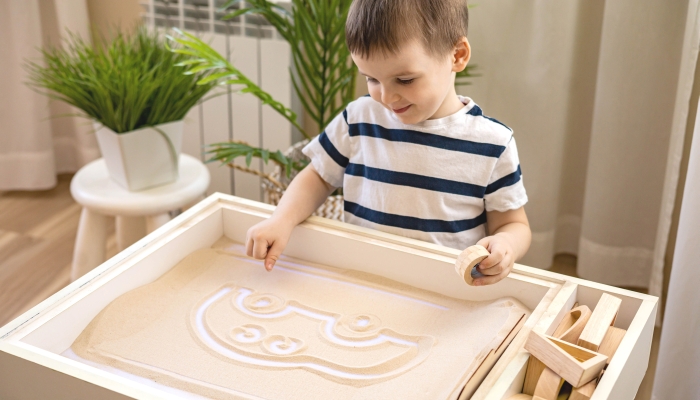What is a Sensory Diet?

- A sensory diet is a prescribed set of sensory activities throughout a child’s day to assist with sensory processing disorder.
- A sensory diet can help a child feel calmer, more focused, and more organized.
- Together, an occupational therapist and a child’s parent(s) can best design a sensory diet.
- Sensory activities are selected from eight different sensory systems to fit an individual child’s needs and are monitored regularly.
After enrolling her child in gymnastics to help burn energy, a mom reached out to me for support. She was frustrated and exhausted.
Each class ended with an outburst—if her child was able to make it through the whole session. The child struggled to follow directions, was often in other children’s personal space, appeared even clumsier than normal, and was often dysregulated. The mom reported that her child had even more energy at the end of class, and she felt defeated.
With more discussion, it became apparent the child might be struggling with sensory meltdowns. Gymnastics brought lots of physical movement but also included a lot of visual stimulation and loud noises. Her child was overstimulated by it and, as a result, was responding in inappropriate and unexpected ways.
With the support of occupational therapy, this mom learned about sensory diets and how to better support her child’s sensory needs throughout the day. Understanding what a sensory diet is and how to implement it can help a child feel calmer and more in control.
For kids that become overstimulated or understimulated throughout the day, a sensory diet can be effective in helping them feel either calm or more alert.
Sensory Diet: What Is It?

Some children become overstimulated when their brain receives sensory input from the eight senses within their body, while other children become understimulated. This misinterpretation of sensory input is called sensory processing disorder (SPD).
When a child with SPD craves sensory input or is sensory seeking, they tend to be understimulated by sensory input and seek more sensory stimulation. A sensory seeking child becomes more dysregulated when they receive more sensory stimulation.
On the other hand, when a child is sensory avoiding, they tend to be overstimulated by sensory input and therefore tend to avoid sensory stimulation.
Children with sensory processing disorders are sometimes prescribed a sensory diet to help them feel calmer, more focused, and more organized. Sensory diets can utilize an occupational therapy technique called sensory integration. Through specialized physical and sensory activities and prescribed play, children learn how to take in information their body receives through their senses, process it, and then respond correctly.
What is a Sensory Diet?
A sensory diet is a specific plan of physical activities typically created by an occupational therapist to meet a child’s unique sensory needs. The term sensory diet was originally coined by Patricia Willbarger in 1995 and has since been used by occupational therapists to help children have more appropriate responses to environmental stimulation.
There is limited research on the effectiveness of sensory diets. However, a dissertation from 2018 by Vidya Pingale, MS, titled The Effects Of Sensory Diets On Children With Sensory Processing Disorder found that sensory diets did help the kids in the study participate better in activities in a classroom setting. It also found that sensory diets helped children feel more comfortable and in control by helping prevent sensory and emotional overload.
What Does a Sensory Diet Include?
A sensory diet includes specific sensorimotor activities that can be used at home or at school. These activities focus on the different sensory systems:
- Auditory system (hearing)
- Olfactory system (smell)
- Gustatory system (taste)
- Visual system (sight)
- Tactile system (touch)
- Vestibular system (balance)
- Proprioceptive system (body awareness)
- Interoception (internal sensations)
An occupational therapist (OT) that understands sensory processing difficulties can best design a sensory diet to meet a child’s specific sensory profile. One of the trickiest aspects of a sensory diet is knowing when to add or restrict sensory input. An OT is able to identify when a child overreacts or underacts to sensory stimulation and therefore knows when to encourage or restrict sensory input.
What Is the Purpose of a Sensory Diet?

Similar to providing a variety of healthy foods in a diet to meet your child’s nutritional needs, a sensory diet offers the right amount and type of stimulation to meet their sensory needs. Sensory diet activities are individualized to a child’s sensory issues and are organized into a schedule to be used throughout the day.
How Does a Sensory Diet Help?
By providing consistent and specific amounts of sensory input throughout the day, a sensory diet helps prevent a child from experiencing sensory overload or underwhelm. The proper amount and type of sensory stimulation throughout the day can help a child have more appropriate responses to environmental stimuli over time.
When a child’s nervous system receives specific sensory experiences the child can feel calmer, remain focused, and be more organized. When children feel calmer, they can participate easier in activities and daily routines.
Incorporating sensory activities that focus on the specific sensory system needs of each individual child can help a child focus better in school, learn new school and socialize with other kids.
What Are the Benefits of a Sensory Diet?
When a sensory diet is designed by a professional and implemented consistently at home or school, it helps build self-awareness. Self-regulation can occur as some children begin to seek or select healthy and appropriate sensory stimulation. A sensory diet can help develop the foundational skills needed to more effectively engage with the world.
How Long Does a Sensory Diet Last?
Most sensory diets are administered for at least 10–14 days. Effective sensory diets focus on the duration, timing, and intensity of sensory strategies for each individual child. Sensory activities are repeated frequently throughout the day as daily tasks, in a scheduled manner to prevent sensory overload or a reactive response due to too much sensory input.
In order for a sensory diet to be successful, it should be created by an occupational therapist or another professional that understands sensory processing issues. This personalized sensory diet needs to be monitored and revised regularly based on the child’s progress to ensure the sensory strategies implemented continue to meet an individual’s sensory needs.
How to Tell if Your Child Needs a Sensory Diet?

Children with SPD or other sensory issues can benefit from a sensory diet. A child struggling with sensory processing issues dysregulates or has sensory meltdowns often. But keep in mind that there is a difference between tantrums and meltdowns.
Unlike behavioral tantrums typically caused by frustration for not getting a want or desire, like a bedtime tantrum, sensory meltdowns are caused by overstimulation. After a tantrum, children are not emotionally drained and can recover quickly, whereas children appear inconsolable and don’t recover quickly after a sensory meltdown.
When a child’s sensory system can’t process stimuli correctly or efficiently, the child responds in an inappropriate or unexpected way. This sensory over-responsiveness will lead a child to try and find more sensory input or stay away from sensory input.
Children with autism spectrum disorders (ASD) and attention deficit hyperactivity disorder (ADHD) can also benefit from sensory diets to help manage sensory experiences.
When Should a Child Undergo a Sensory Diet?
If your child is having sensory meltdowns or has sensory processing dysfunction, they would probably benefit from a sensory diet. A child with sensory processing issues might:
- Be overly active and unable to settle.
- Appear overstimulated, wild, or “wound up” when engaging in physical activity.
- Be too rough in play.
- Struggle following directions.
- Have sleep issues.
- Struggle with impulsivity.
- Have poor social interactions.
- Struggle with emotional regulation.
- Appear day-dreamy often or tired and lethargic.
- Have poor personal space boundaries.
Guide to Starting Your Child on a Sensory Diet

With your valuable input as the parent and the occupational therapist’s expertise, you can create a sensory diet that focuses on your child’s sensory challenges. A specific plan of activities within a schedule will help your child feel calmer and more regulated.
To create a sensory diet, activities need to incorporate physical activities and sensory stimuli that focus on the specific sensory systems a child needs input from. Understanding which sensory information your child needs in a given moment helps you select the appropriate sensory activity that will help them feel calm.
Auditory Input
A sensory diet for children that have difficulty organizing auditory input might include:
- Playing a musical instrument.
- Listening to music.
- Listening to nature sounds (running water, rain, birds).
- Using noise-reduction headphones.
Tactile Input
Our tactile sense can involve physical touch, pressure, feeling vibrations, texture, and temperatures. A child’s sensory diet that focuses on the tactile system might include:
- Deep pressure massage.
- Playing with sand, shaving cream, slime, or playdoh.
- Using a weighted blanket.
Olfactory Input
Some children are very sensitive to overwhelming odors and smells, while some smells can be calming. Sensory activities that focus on the sense of smell might include:
- Coloring with scented markers.
- Using essential oils or lotions.
- Chewing gum.
Gustatory Input
The gustatory system is directly connected to the olfactory system. We interpret taste based on our sense of smell. Taste input also includes oral input of textures and movements. For example, you might suggest your child chew gum to increase the input of taste and oral movement. Other activities might include:
- Eating chewy or crunchy foods.
- Trying strong tasting foods, like sour gummies or peppermint.
Proprioceptive Input
The proprioceptive system is the ability to be aware of our body in relation to space. A child with poor coordination and balance might have sensory needs for more proprioceptive input. These sensory activities are usually physical activities and might include:
- Pushing a stroller or car with heavy objects.
- Pulling heavy objects.
- Wheelbarrow walking.
- Playing hopscotch.
- Deep pressure.
Visual Input
Children have different sensory preferences for visual stimulation. For some children, a classroom or overly decorated space can be visually overstimulating and a child might have difficulty focusing while other children might need more visual input to engage.
When a child is overwhelmed by visual stimuli, try to simplify the environment. If a child seems uninterested or zoned out, try adding bright colors to capture visual attention. Other visual stimuli activities include:
- Visual scanning activities, like connect the dots, word searches, picture searches, and mazes.
- Reducing visual clutter.
- Being aware of colors that distress your child more than others.
Vestibular Input
Vestibular input is our sense of balance and movement regulated by the inner ear. Physical movement provides vestibular input but children with vestibular sensitivities typically require more input than others. Seek feedback from your OT for the right amounts of vestibular stimulation to prevent negative reactions. These activities might include:
- Spinning on a sit-n-spin or office chair.
- Swinging.
- Hanging upside down.
- Sitting, rolling, or bouncing on a therapy ball.
Interoceptive Input
Interoception is the awareness of internal sensations such as hunger, thirst, and stomach pain.. Interoception activities include bringing more awareness to a child’s body and slowing down. Activities include:
- Yoga.
- Mindfulness activities.
- Breathing exercises.
- Discussing emotions and playing emotional awareness games.
With consistency and ongoing progress evaluation, your child will learn to better manage their sensory needs to have a productive and calmer interaction with the world around them.
Reference
Pingale, V. (2018). The effects of sensory diets on children with sensory processing … – TDL. Texas Woman’s University Libraries. https://twu-ir.tdl.org/bitstream/handle/11274/11009/PINGALE-DISSERTATION-2018.pdf?sequence=1

Related Posts

Behavior
Understanding Intermittent Explosive Disorder in Children
Are you worried about your child’s unexpected aggression and explosive behaviors? Learn how to support a child with intermittent explosive disorder.

Behavior
5 Emotional Regulation Activities for Kids
Want to teach your child how to regulate emotions? Here are emotional regulation activities for kids that can help!

Behavior, Special Needs
5 Tips for Dining Out with Children Who Have Sensory Sensitivities
Worried about dining out with sensory sensitivities? Try these tips for less stress and more fun the next time you take your family out to eat.